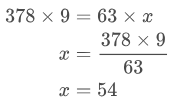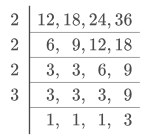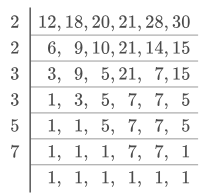Session 7: Lowest Common Multiple (L.C.M.) – Definition, Methods, Steps, Interactives and Examples
What are Common Multiples?
In the lesson ‘Multiples’, we learnt that a multiple is a product obtained when one number is multiplied by another number. In this section, we will look at multiples that are common among the multiples of two or more numbers. These multiples are known as common multiples.
To find the common multiples of 2 and 4, we list the multiples of 2 and 4 separately and then find the multiples that are common in both lists.

When we compare the first ten multiples of 2 and 4, we find that they have five common multiples, i.e., 4, 8, 12, 16 and 20. There will be more if we continue to look for more multiples.
The common multiples of two or more numbers are the numbers that are completely divisible by each of the given numbers.
1) Find the common multiples of 3, 4 and 8
First, write down the first few multiples for the numbers and then identify the multiples the three numbers have in common.
Multiples of 3−3,6,9,12,15,18,21,24,27,30,33,36,39,42,45,48,51,…
Multiples of 4−4,8,12,16,20,24,28,32,36,40,44,48,52,…
Multiples of 8−8,16,24,32,40,48,56,…
Then, identify the common multiples.

Some of the common multiples of 3, 4 and 8 are 24, 48,…
Steps to find Common Multiples
To find common multiples, we follow the following steps:
Step 1: List down some multiples of the given numbers in separate rows.
Step 2: Identify all the multiples that are common in the given numbers.
Step 3: Write down all the common multiples in a separate row.
Lowest Common Multiple (L.C.M.)
The smallest number, which is a common multiple of two or more given numbers, is called their lowest common multiple (L.C.M.). In other words, it is the lowest possible number that can be divisible by the given numbers.
2) Find the L.C.M. of 3 and 4.
Let’s look at the common multiples for 3 and 4.

Some of the common multiples of 3 and 4 are 12, 24 and 36. The L.C.M. of these two numbers is 12. It is the smallest number that they both have in common.
Methods to Find L.C.M.
The three commonly used methods for finding the L.C.M. of two or more numbers are:
- Listing method
- Prime factorization
- Common Division method
Finding L.C.M. by the Listing Method
In this method, first, list down some multiples of each given number and find the multiples that are common in those numbers. Then, among the common multiples, we identify the lowest common multiple. Let’s understand this method using an example.
3) Find the L.C.M. of 4 and 5.
First, list down some multiples of 4 and 5.
Multiples of 4−4, 8, 12, 16, 20, 24, 28, 32, 36, 40, …
Multiples of 5−5, 10, 15, 20, 25, 30, 35, 40, 45, 50 …
Now, look for the common multiples of 4 and 5.

20, 40, … are common multiples, but 20 is the smallest.
So, L.C.M.(4,5)=20.
Steps to Find L.C.M. using the Listing Method
To find the L.C.M. of two or more numbers using lists, we follow the following steps:
Step 1: List down some multiples of the given numbers in separate rows.
Step 2: Identify all the multiples that are common in the given numbers
Step 3: Identify the smallest number in the list of common multiples. This number is the required L.C.M.
Finding L.C.M. by Prime Factorization Method
In this method, we find the prime factorization of each number using the division method. L.C.M. of the given numbers is the product of all the different prime factors using each common prime factor occurring the maximum number of times. Let’s understand this method using an example.
4) Find the lowest common multiple of 84 and 90.
First, write down the prime factorization of each number and collect the maximum number of occurrences of each prime factor.


Notice that 2 has occurred two times and 3 has occurred two times, 5 one time and 7 one time. Next, multiply the prime factors with maximum occurrences in the prime factorization to find the required L.C.M.
Hence, L.C.M.(84,90)=2×2×3×3×5×7=1260.
Steps to Find L.C.M. using the Prime Factorization Method
To find the L.C.M. of two or more numbers using the prime factorization method, we follow the following steps:
Step 1: Write the prime factorization of the given numbers using the division method.
Step 2: Find the maximum number of occurrences of each prime factor.
Step 3: Find the product of the prime factors with maximum occurrences in the prime factorization to obtain the required L.C.M.
Finding L.C.M. by the Common Division Method
In this method, we divide the given numbers by a prime number, which is a factor of at least one of the given numbers. The resultant quotients are again divided by a prime number. We continue this process until no common factor other than 1 is in the last row. The required L.C.M is the product of all the divisors and the undivided numbers.
5) Find the L.C.M. of 35 and 40.
2 is the smallest prime number, and it is a factor of 40. Write 2 on the left of the two given numbers.
2 divides 40, but it is not a factor of 35, so we write the number 35 in the row below as it is. We continue this process until no common factor other than 1 is in the last row.

∴L.C.M.(35,40)=2×2×2×5×7=280.
Steps to Find L.C.M. using the Common Division Method
To find the L.C.M. of two or more numbers using the common division method, we follow the following steps:
Step 1: Divide the given numbers by a prime number, which is a factor of at least one of the given numbers and write the resultant quotients.
Step 2: The resultant quotients are again divided by a prime number.
Step 3: Repeat step 2 until no common factor other than 1 is left.
Step 4: Find the product of all the divisors to obtain the required L.C.M.
Relationship between L.C.M. and H.C.F.
Consider the numbers 24 and 36.
The prime factorization of 24=2×2×2×3 and that of 36=2×2×3×3.
H.C.F.(24,36)=2×2×3=12
L.C.M.(24,36)=2×2×2×3×3=72
Product of the given numbers=24×36=864.
Product of H.C.F. and L.C.M.=12×72=864.
Therefore, we can write it as follows:
H.C.F. of the numbers × L.C.M. of the numbers = The product of the two numbers
If a and b are the two given numbers, then the L.C.M. and H.C.F. are related to the given numbers by the following relationship
L.C.M.(a,b)×H.C.F.(a,b)=a×b
6) L.C.M. of two numbers is 378, and their H.C.F. is 9. If one of the numbers is 63, then find the other number.
We know that L.C.M. × H.C.F. = Product of numbers.
Let the second number be x.

∴ The other number is 54.
Properties of L.C.M and H.C.F
Property 1: The H.C.F. of given numbers is smaller than or equal to the smallest number. For example, H.C.F. of 12, 16 and 32 is 4, and that of 5, 10 and 15 is 5.
Property 2: The L.C.M. of given numbers is greater than or equal to the largest of the numbers. For example, L.C.M. of 12, 16 and 32 is 96, and that of 6, 9, 18 is 18.
Property 3: The H.C.F. of two numbers a and b is a factor of the L.C.M. of a and b. Likewise, L.C.M. of a and b is a multiple of H.C.F. of a and b.
For example, H.C.F. of 12 and 16 is 4, and their L.C.M. is 48. Clearly, 4 is a factor of 48. Also, 48 is 12 times 4, i.e., L.C.M. 48 is a multiple of H.C.F. 4.
Property 4: If the H.C.F. of two numbers is one of the numbers, then the L.C.M. of the numbers is the other number. For example, H.C.F. of 15 and 75 is 15, and their L.C.M. is 75.
Property 5: The L.C.M. of two co-prime numbers is equal to the product of the numbers. For example, L.C.M. of 4 and 9 is 36, which is equal to their product 4×9.
Property 6: The product of the H.C.F. and the L.C.M. of two numbers, a and b is equal to their product a×b.
Lowest Common Multiple (L.C.M.) – Examples
Example 1
Find the L.C.M. of 20 and 24 using lists.
First, list the multiples of 20 and 24; stop at the first common multiple.

The L.C.M. of 20 and 24 is 120.
Example 2
Find the L.C.M. of 36, 40 and 126 using prime factorization.
First, write down the prime factorization of each of the numbers.

Next, collect the maximum number of occurrences of each prime factor.

Notice that 2 has occurred 3 times and 3 has occurred two times, 5 one time and 7 one time.
L.C.M.(36,40,126)=2×2×2×3×3×5×7=2520
Example 3
Find the L.C.M. of 12, 18, 24 and 36 by common division method.
We have,

∴ L.C.M.(12,18,24,36)=2×2×2×3×3=72.
Example 4
Find the least number from which if 35 is subtracted, the result is exactly divisible by 12, 18, 20, 21, 28 and 30.
We know that the least number divisible by 12, 18, 20, 21, 28 and 30 is their L.C.M. Therefore, the required number must be 35 more than their L.C.M. We calculate L.C.M. as under

∴L.C.M.(12,18,20,21,28,30)=2×2×3×3×5×7
=1260
Hence, the required number=1260+35=1295.
Remember this!
- A multiple is a product obtained when one number is multiplied by another number.
- A number that is a multiple of each given number is called a common multiple.
- The smallest number, which is a common multiple of two or more given numbers, is called their lowest common multiple (L.C.M).
- The H.C.F. and L.CM of two given numbers are related to the given numbers by the following relationshipThe product of two numbers = The product of their L.C.M. and H.C.F.
